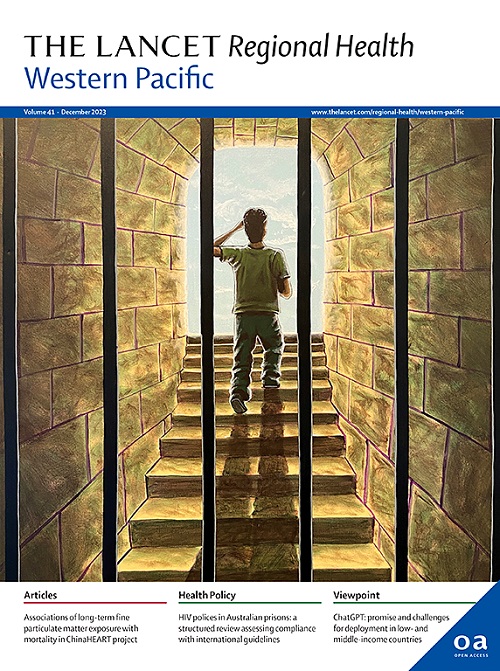Mapping residual malaria transmission in Vietnam
IF 8.1
1区 医学
Q1 HEALTH CARE SCIENCES & SERVICES
引用次数: 0
Abstract
Background
Vietnam, as one of the countries in the Greater Mekong Subregion, has committed to eliminating all malaria by 2030. Declining case numbers highlight the country's progress, but challenges including imported cases and pockets of residual transmission remain. To successfully eliminate malaria and to prevent reintroduction of malaria transmission, geostatistical modelling of vulnerability (importation rate) and receptivity (quantified by the reproduction number) of malaria is critical.
Methods
Case data from 2019 to 2022 was used to train a range of network and geostatistical models, from which strategically useful metrics were computed. These metrics include vulnerability, which was estimated from the abundance of imported cases, and receptivity, which was estimated based on a transmission model linking cases as well as environmental covariate data.
Findings
There is considerable spatiotemporal heterogeneity in the computed metrics. Importations are concentrated in the South Central Coast and Central highlands regions. The importation rate of Plasmodium falciparum is around 2.5 times higher than that of P. vivax. The mean computed reproduction number is less than one, which is consistent with the historical decline in cases and eventual elimination. There are, however, places where the estimated reproduction number can temporarily exceed one, which explains the seasonal case resurgence observed in the case data. The reproduction number is typically higher in forested areas.
Interpretation
Receptivity and vulnerability to malaria is spatiotemporally heterogeneous in Vietnam. Despite the average reproduction number being less than one, the spatial pockets and temporal windows of elevated reproduction number could prevent timely elimination of malaria or even lead to a reversal of progress. The predictive maps presented in this paper can inform appropriate intervention strategies to advance goals of malaria elimination.
Funding
This work was supported, in whole or in part, by the Bill & Melinda Gates Foundation [INV-055192 and INV-009390/OPP1197730]. The conclusions and opinions expressed in this work are those of the author(s) alone and shall not be attributed to the Foundation. Under the grant conditions of the Foundation, a Creative Commons Attribution 4.0 License has already been assigned to the Author Accepted Manuscript version that might arise from this submission. Please note works submitted as a preprint have not undergone a peer review process. This work also includes funding support from the Australian Government, National Health and Medical Research Council (Award No: GNT2025280) and Telethon Trust, Western Australia.
绘制越南疟疾残留传播图
越南作为大湄公河次区域国家之一,已承诺到2030年消除所有疟疾。病例数的下降凸显了该国取得的进展,但包括输入病例和少量残留传播在内的挑战仍然存在。为了成功地消除疟疾和防止疟疾传播的重新引入,对疟疾的易感性(输入率)和接受性(按繁殖数量化)进行地质统计建模至关重要。方法利用2019年至2022年的案例数据,训练一系列网络和地质统计模型,从中计算出具有战略意义的指标。这些指标包括脆弱性(根据大量输入病例估计)和可接受性(根据连接病例和环境协变量数据的传播模型估计)。研究结果计算指标存在相当大的时空异质性。进口主要集中在南部中部海岸和中部高地地区。恶性疟原虫的输入率是间日疟原虫的2.5倍左右。平均计算繁殖数小于1,这与病例的历史下降和最终消除是一致的。然而,在一些地方,估计的繁殖数可能暂时超过1,这解释了病例数据中观察到的季节性病例死灰复燃。在森林地区,繁殖数量通常较高。越南对疟疾的接受性和脆弱性具有时空异质性。尽管平均繁殖数小于1,但繁殖数升高的空间口袋和时间窗口可能会阻碍疟疾的及时消除,甚至导致进展的逆转。本文提出的预测图可以为适当的干预策略提供信息,以推进消除疟疾的目标。这项工作全部或部分地得到了比尔基金会的支持。梅琳达·盖茨基金会[INV-055192和INV-009390/OPP1197730]。本工作中表达的结论和观点仅代表作者的观点,不归基金会所有。在基金会的授权条件下,知识共享署名4.0许可证已经被分配给作者接受的手稿版本。请注意,作为预印本提交的作品没有经过同行评审过程。这项工作还包括澳大利亚政府、国家卫生和医学研究委员会(奖励号:GNT2025280)和西澳大利亚Telethon信托基金的资金支持。
本文章由计算机程序翻译,如有差异,请以英文原文为准。
求助全文
约1分钟内获得全文
求助全文
来源期刊

The Lancet Regional Health: Western Pacific
Medicine-Pediatrics, Perinatology and Child Health
CiteScore
8.80
自引率
2.80%
发文量
305
审稿时长
11 weeks
期刊介绍:
The Lancet Regional Health – Western Pacific, a gold open access journal, is an integral part of The Lancet's global initiative advocating for healthcare quality and access worldwide. It aims to advance clinical practice and health policy in the Western Pacific region, contributing to enhanced health outcomes. The journal publishes high-quality original research shedding light on clinical practice and health policy in the region. It also includes reviews, commentaries, and opinion pieces covering diverse regional health topics, such as infectious diseases, non-communicable diseases, child and adolescent health, maternal and reproductive health, aging health, mental health, the health workforce and systems, and health policy.
 求助内容:
求助内容: 应助结果提醒方式:
应助结果提醒方式:


